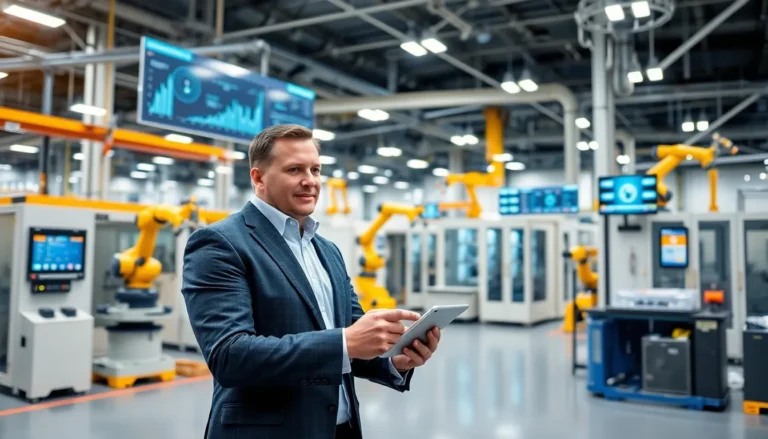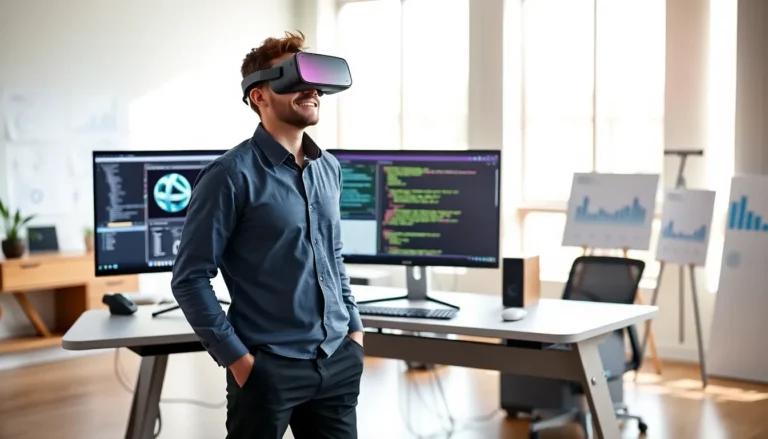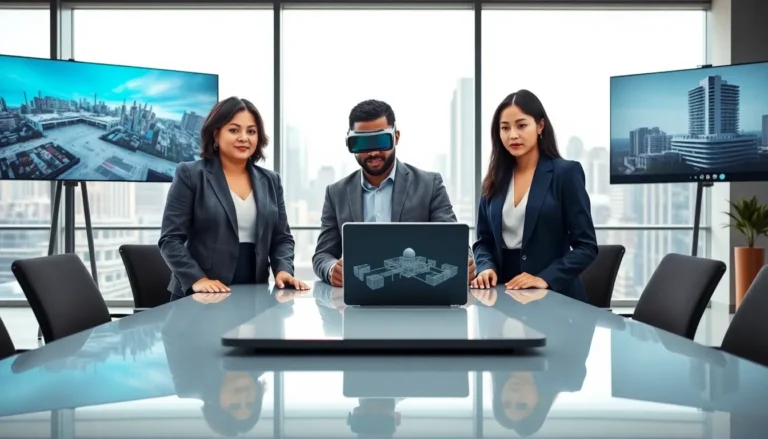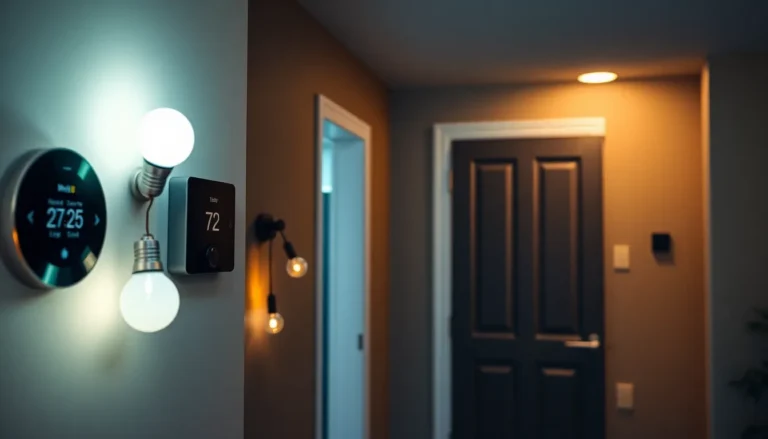The Internet of Things (IoT) is no longer just a buzzword; it’s a full-blown revolution taking the world by storm. Imagine your fridge reminding you to buy milk while your thermostat adjusts itself to your favorite temperature, all while you kick back on the couch. Sounds like sci-fi, right? But it’s happening now, and the trends shaping this digital landscape are nothing short of fascinating.
Table of Contents
ToggleOverview of IoT Trends
Rapid advancements in IoT technology illustrate its growing impact on daily life. Increased connectivity among devices contributes to enhanced automation and efficiency. Key trends in this field include the rise of edge computing, which processes data closer to the source, reducing latency and bandwidth usage.
Additionally, artificial intelligence (AI) integration enables smarter data analysis and decision-making. Smart homes are becoming mainstream, with connected devices managing everything from lighting to security. Wearable technology empowers users by providing real-time health monitoring and analytics.
Data security has emerged as a critical focus, given the increasing number of connected devices. Organizations are prioritizing robust security measures to protect user information. Sustainability trends also influence IoT, as businesses leverage connected technologies to optimize energy consumption and reduce waste.
5G technology plays a vital role in driving IoT growth by supporting a higher volume of connected devices and faster data transfer rates. Real-time analytics become more achievable with this improved connectivity, enabling businesses to respond swiftly to market changes.
The industrial application of IoT, known as Industry 4.0, revolutionizes manufacturing processes through predictive maintenance and smart supply chain management. Businesses are adopting IoT solutions to enhance operational efficiency, increase productivity, and decrease downtime.
The ongoing evolution of IoT reflects a significant trend toward a more interconnected and data-driven future. Continued investment in research and development promises even more innovations, shaping the digital landscape for years to come.
Current Trends in IoT

The landscape of the Internet of Things (IoT) is rapidly evolving. Current trends illuminate the advancements shaping this digital revolution.
Growth of Smart Devices
Smart devices are proliferating across households and industries. Millions of smart appliances now connect to the internet, enhancing convenience and efficiency. For example, smart thermostats optimize energy use, while security cameras provide real-time monitoring and alerts. With the global smart home device market projected to reach 135 billion dollars by 2025, the demand for connected technologies is clear. Additionally, businesses integrate smart sensors into manufacturing processes to improve operations and productivity. The increase in smart devices signifies a shift towards smarter living.
Integration with AI
Artificial intelligence is becoming integral to IoT systems. As AI processes vast amounts of data generated by IoT devices, it enables real-time insights and automation. Smart assistants utilize AI for voice recognition, streamlining user interactions with connected home systems. Industries harness AI-powered analytics for predictive maintenance, helping prevent equipment failures and reduce downtime. The fusion of AI and IoT enhances decision-making, fostering smarter solutions across sectors. Market research indicates that AI-enabled IoT products could generate over 36 trillion dollars in additional economic value by 2025, highlighting the significance of this integration.
Edge Computing Innovations
Edge computing is transforming how data is processed in IoT ecosystems. By processing data closer to its source, edge computing reduces latency and bandwidth usage. This innovation enhances the performance of applications, particularly in settings requiring immediate data analysis like autonomous vehicles. Industries implement edge computing to streamline operations, allowing for quicker responses in dynamic environments. Emerging technologies continue to bolster edge computing capabilities, enabling a more efficient flow of information. Studies predict that the edge computing market will grow at a compound annual growth rate of 34 percent, underscoring its critical importance in IoT advancement.
Emerging Technologies in IoT
Emerging technologies are continuously reshaping the landscape of the Internet of Things. Innovations such as 5G connectivity and blockchain applications are crucial in enhancing device performance and security.
5G Connectivity
5G technology significantly impacts IoT by enabling higher data transfer rates and lower latency. It supports billions of connected devices seamlessly, facilitating real-time communication. By 2025, the number of global 5G connections is expected to surpass 1.7 billion, transforming various industries including healthcare and transportation. Smart cities benefit from this connectivity, as it enhances traffic management and public safety systems. Enabling faster response times in critical applications, 5G fosters innovation and improves operational efficiency across sectors.
Blockchain Applications
Blockchain technology offers valuable solutions for data security and integrity in IoT ecosystems. It ensures secure transactions among connected devices, minimizing risks of cyber threats. Companies are increasingly adopting blockchain to manage supply chain data, enhancing transparency and traceability. According to industry reports, blockchain’s integration into IoT is projected to generate $15 billion in value by 2027. Solutions leveraging blockchain enable automated smart contracts, improving operational processes. Adopting this decentralized approach empowers organizations to build trust in their IoT applications.
Challenges Facing IoT Implementation
Challenges impede the full realization of IoT potential, primarily concerning security and interoperability. Addressing these challenges is crucial for successful deployment across various sectors.
Security Concerns
Cybersecurity remains a top priority due to widespread vulnerabilities inherent in interconnected devices. Over 75% of IoT devices face risks from inadequate security features, exposing organizations to potential data breaches. Encryption technologies serve as critical tools, offering protection for data in transit and at rest. Additionally, ongoing software updates help mitigate vulnerabilities by addressing newly discovered threats. Organizations must also implement thorough security protocols to ensure compliance with industry standards and regulations. A comprehensive approach fosters user trust, which becomes essential as IoT adoption increases.
Interoperability Issues
Interoperability issues arise from the diversity of platforms and devices within the IoT ecosystem. Various communication protocols, such as Zigbee, Z-Wave, and Wi-Fi, contribute to this fragmented landscape. It’s estimated that interoperability challenges can increase operational costs by up to 30%. To enhance compatibility, standards organizations like the IEEE and the Open Connectivity Foundation develop universal protocols for seamless communication between devices. By facilitating integration across different systems, these efforts lead to improved functionality and user experience. A focus on interoperability paves the way for broader IoT adoption and maximizes technological benefits.
Future Outlook for IoT Trends
The future of IoT trends shows significant growth across various sectors. Smart home devices keep gaining traction, with the global market projected to reach $135 billion by 2025. Moreover, AI integration in IoT systems offers enhanced real-time insights and automation, generating over $36 trillion in added economic value.
Edge computing innovations significantly impact data processing efficiency. The expected compound annual growth rate of 34% underscores its importance in reducing latency and improving performance in dynamic environments.
Emerging technologies such as 5G and blockchain play pivotal roles in the IoT ecosystem. With 5G connections anticipated to exceed 1.7 billion by 2025, industries like healthcare and transportation will experience transformative changes. Blockchain technology enhances data security and integrity, generating $15 billion in value by 2027 while increasing supply chain transparency.
Challenges remain that affect IoT’s full potential. Cybersecurity risks significantly jeopardize interconnected devices, with over 75% of IoT devices vulnerable due to inadequate security measures. Protecting data requires robust encryption and continuous software updates.
Interoperability presents another hurdle. The diversity of platforms and devices can inflate operational costs by up to 30%. Organizations are collaborating to develop universal protocols, improving compatibility and user experience.
Expectations for IoT innovations reflect ongoing investment in research. Continuous advancement can lead to a more interconnected and data-driven future, revolutionizing industries and enhancing everyday life through automation and efficiency.
The future of IoT trends is poised for remarkable growth and innovation. As smart home devices and AI integration become more prevalent, they’ll drive economic value and operational efficiency across various sectors. The emphasis on data security and interoperability will be crucial as organizations navigate the complexities of an interconnected world.
Emerging technologies like 5G and blockchain will further enhance the capabilities of IoT, ensuring secure and efficient communication among devices. With ongoing investment in research and development, the IoT landscape will continue to evolve, promising a transformative impact on both industries and daily life. The journey ahead is filled with potential, as increased automation and connectivity redefine how people interact with technology.










